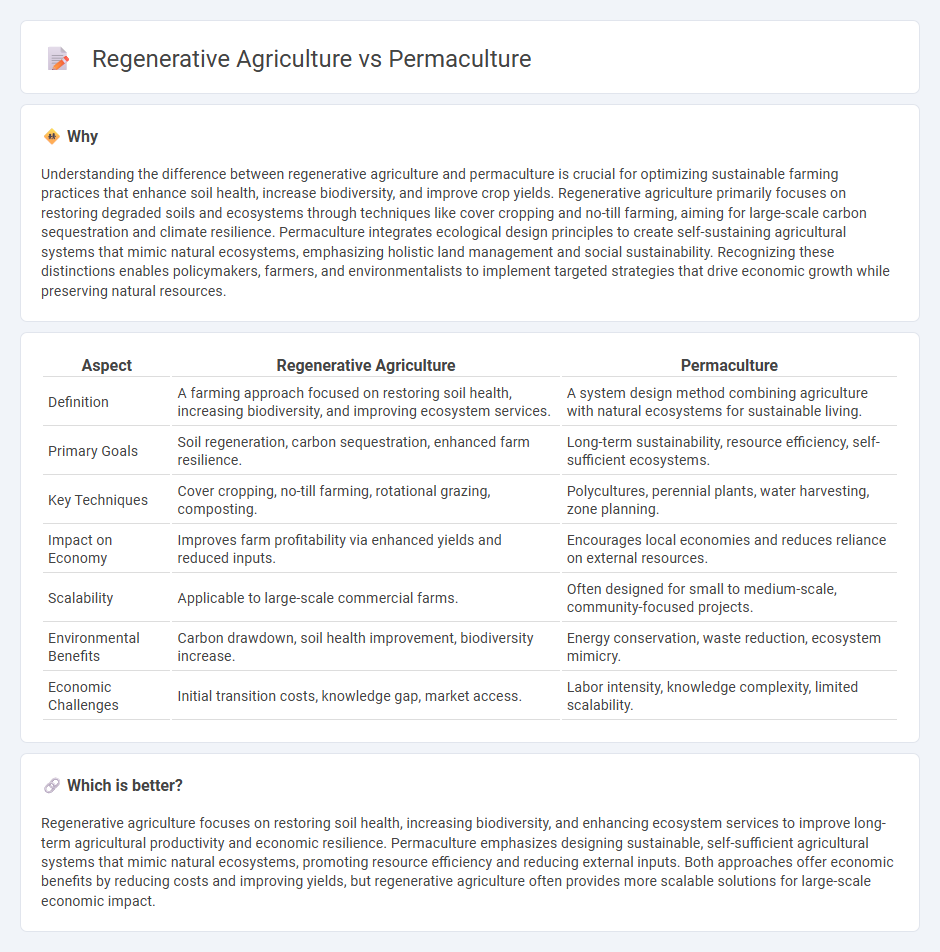
Regenerative agriculture focuses on restoring soil health and enhancing ecosystem services through practices like cover cropping and no-till farming, boosting long-term farm productivity. Permaculture integrates sustainable land use with ecological design principles, emphasizing self-sufficient systems and harmony between people and nature. Explore the key economic impacts and benefits these approaches offer to modern agriculture.
Why it is important
Understanding the difference between regenerative agriculture and permaculture is crucial for optimizing sustainable farming practices that enhance soil health, increase biodiversity, and improve crop yields. Regenerative agriculture primarily focuses on restoring degraded soils and ecosystems through techniques like cover cropping and no-till farming, aiming for large-scale carbon sequestration and climate resilience. Permaculture integrates ecological design principles to create self-sustaining agricultural systems that mimic natural ecosystems, emphasizing holistic land management and social sustainability. Recognizing these distinctions enables policymakers, farmers, and environmentalists to implement targeted strategies that drive economic growth while preserving natural resources.
Comparison Table
| Aspect | Regenerative Agriculture | Permaculture |
|---|---|---|
| Definition | A farming approach focused on restoring soil health, increasing biodiversity, and improving ecosystem services. | A system design method combining agriculture with natural ecosystems for sustainable living. |
| Primary Goals | Soil regeneration, carbon sequestration, enhanced farm resilience. | Long-term sustainability, resource efficiency, self-sufficient ecosystems. |
| Key Techniques | Cover cropping, no-till farming, rotational grazing, composting. | Polycultures, perennial plants, water harvesting, zone planning. |
| Impact on Economy | Improves farm profitability via enhanced yields and reduced inputs. | Encourages local economies and reduces reliance on external resources. |
| Scalability | Applicable to large-scale commercial farms. | Often designed for small to medium-scale, community-focused projects. |
| Environmental Benefits | Carbon drawdown, soil health improvement, biodiversity increase. | Energy conservation, waste reduction, ecosystem mimicry. |
| Economic Challenges | Initial transition costs, knowledge gap, market access. | Labor intensity, knowledge complexity, limited scalability. |
Which is better?
Regenerative agriculture focuses on restoring soil health, increasing biodiversity, and enhancing ecosystem services to improve long-term agricultural productivity and economic resilience. Permaculture emphasizes designing sustainable, self-sufficient agricultural systems that mimic natural ecosystems, promoting resource efficiency and reducing external inputs. Both approaches offer economic benefits by reducing costs and improving yields, but regenerative agriculture often provides more scalable solutions for large-scale economic impact.
Connection
Regenerative agriculture and permaculture share a focus on restoring soil health, enhancing biodiversity, and promoting sustainable land management practices that improve ecosystem resilience. Both approaches contribute to long-term economic benefits by increasing agricultural productivity, reducing input costs, and supporting local economies through sustainable resource use. These methods foster circular economies in agriculture by integrating ecological principles with economic efficiency, driving sustainable growth and environmental stewardship.
Key Terms
Sustainable Systems
Permaculture emphasizes designing self-sustaining ecosystems that integrate plants, animals, and humans to create resilient agricultural systems. Regenerative agriculture prioritizes soil health through practices like cover cropping, no-till farming, and crop rotation to restore biodiversity and carbon sequestration. Explore the unique approaches and benefits of these sustainable systems to enhance your understanding of eco-friendly farming.
Resource Efficiency
Permaculture and regenerative agriculture both emphasize resource efficiency by optimizing natural systems to reduce waste and enhance soil health; permaculture designs integrate sustainable land use patterns, while regenerative agriculture focuses on improving ecosystem functions through practices like cover cropping and holistic grazing. These methods improve water retention, increase biodiversity, and bolster carbon sequestration, making them vital for climate resilience. Explore how these approaches can transform agricultural sustainability and resource management.
Circular Economy
Permaculture and regenerative agriculture both emphasize sustainable land use by promoting soil health, biodiversity, and resource efficiency, aligning closely with circular economy principles that minimize waste and maximize resource recycling. Permaculture integrates diverse plant and animal species to create self-sustaining ecosystems, while regenerative agriculture focuses on restoring degraded soils through practices like cover cropping, no-till farming, and holistic grazing. Explore deeper ways these systems contribute to circular economy models and sustainable food production.
Source and External Links
Permaculture - Wikipedia - Permaculture is an approach to land management and settlement design inspired by natural ecosystems, focusing on regenerative agriculture, community resilience, and sustainable design principles developed by Bill Mollison and David Holmgren since 1978.
What is Permaculture? And How to Apply It to Your Garden - Permaculture is a holistic philosophy combining permanent agriculture and cultural needs to create sustainable systems that work with nature, including practices like hugelkultur, rainwater harvesting, and composting.
Permaculture: You've Heard of It, But What the Heck Is It? - Permaculture is a comprehensive ecological design system aiming for self-sufficiency by stacking multiple functions in landscape elements, emphasizing water conservation through earthworks like swales and terraces.
 dowidth.com
dowidth.com